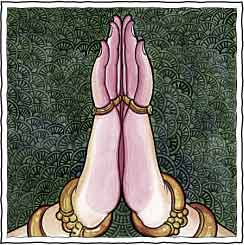|
MUDRA ANJALI / NAMASKARA
A common gesture of greeting, respect
and reverence which is usually offered
between equals, or from junior to
senior. Because Buddha is the most
senior of all, it is rarely found on a
Buddha statue.
The anjali is a symbol of unity where the two opposites:
the left and the right, the black and white, yin and yang,
male and female, etc (i.e. the whole dichotomous
universe) comes together as one.
The union of the hands occurs over the heart center, the
place of emotion, of love, etc. The hands form the shape of
a lotus bud which is a potent image in itself, rich with
symbolism. The hands can also be seen as forming a diamond
(shape) with the two 'worlds' joined the resulting union is
seen as symbolic of the eternal, indestructible truth that
is the Dharma. The interlocking ten fingers represent the
ten paramittas (or virtues).
In the West, we translate this gesture as a posture of
prayer. Because we have grown up with this gesture as part
of our culture, each of us probably has our own personal
connection to this mudra—positive or negative. Some of us
may find a subconscious resistance to bringing our hands
together as if it were a sign of submission. However, the
beauty of this gesture, which positions us right at the core
of our being, is timeless and universal.
|

WORLD RELIGIONS
COMPARED
WORLD
RELIGIONS CLIPART
WORLD
RELIGIONS HOME
HINDUISM HOME
MUDRA HOME |